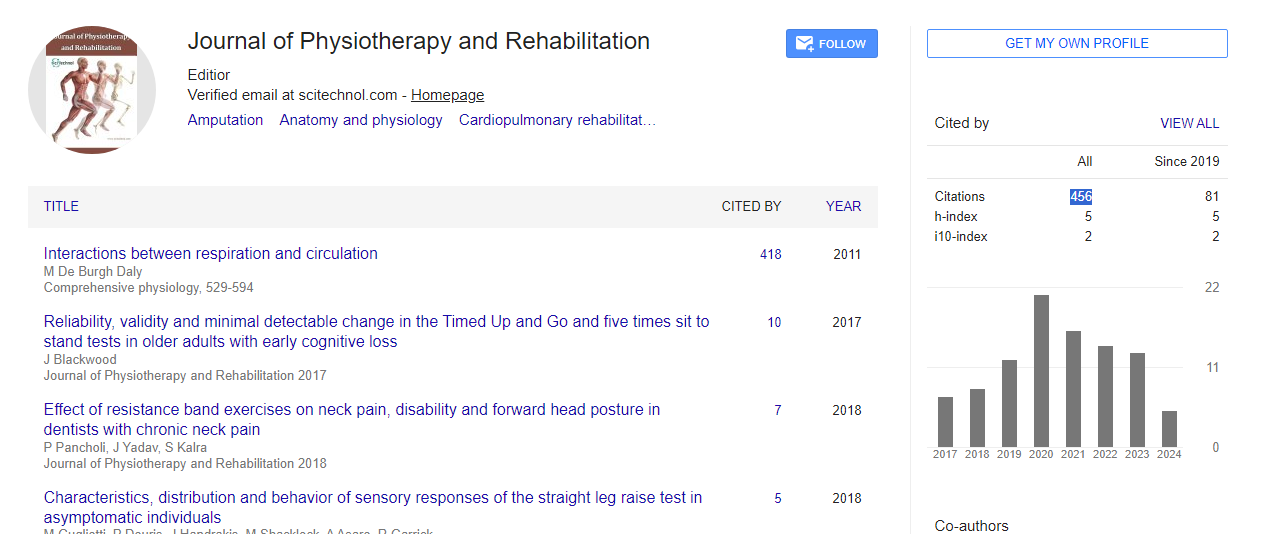Opinion Article, J Physiother Rehabi Vol: 8 Issue: 3
Telemedicine in Rheumatological Rehabilitation: Enhancing Access and Care Delivery
Darry Kanen*
1Department of Physical Medicine and Rehabilitation, Wayne State University, Detroit, Michigan, USA
*Corresponding Author: Darry Kanen,
Department of Physical Medicine
and Rehabilitation, Wayne State University, Detroit, Michigan, USA
E-mail: kanenda@rry.edu
Received date: 28 May, 2024, Manuscript No. JPTR-24-140181;
Editor assigned date: 30 May, 2024, PreQC No. JPTR-24-140181 (PQ);
Reviewed date: 13 June, 2024, QC No. JPTR-24-140181;
Revised date: 21 June, 2024, Manuscript No. JPTR-24-140181 (R);
Published date: 28 June, 2024, DOI: 10.4172/JPTR.1000164.
Citation: Kanen D (2024) Telemedicine in Rheumatological Rehabilitation: Enhancing Access and Care Delivery. J Physiother Rehabi 8:3.
Description
Telemedicine has emerged as a transformative approach in healthcare, offering new opportunities to expand access to specialized services and improve care delivery for individuals with rheumatological conditions. Rheumatological conditions, such as rheumatoid arthritis, osteoarthritis, lupus, and gout, present complex challenges that require ongoing monitoring, timely intervention, and personalized treatment plans. Historically, access to specialized rheumatological care has been limited by geographical barriers, shortages of rheumatologists in rural areas, and long wait times for appointments. Telemedicine addresses these challenges by leveraging technology to facilitate remote consultations, monitoring, and education, thereby enhancing access to comprehensive care for patients regardless of their location.
Benefits of telemedicine in rheumatological rehabilitation
Telemedicine enables patients in remote or underserved areas to consult with rheumatologists and multidisciplinary teams without the need for travel. This reduces barriers to accessing timely diagnosis, treatment adjustments, and ongoing management of rheumatological conditions. Patients benefit from timely interventions that can prevent disease progression and improve outcomes. Telemedicine offers convenience by allowing patients to attend virtual appointments from their homes or local healthcare facilities. This flexibility reduces travel time and associated costs, leading to higher appointment adherence rates and improved patient satisfaction. Moreover, telemedicine platforms facilitate ongoing communication between patients and healthcare providers, promoting patient engagement in selfmanagement and adherence to treatment plans.
Remote monitoring technologies, such as wearable devices and digital health applications, enable continuous assessment of disease activity, medication adherence, and functional status. Rheumatologists can remotely monitor disease progression, respond to fluctuations in symptoms, and adjust treatment regimens as needed. This proactive approach enhances continuity of care, minimizes gaps in follow-up, and improves long-term management of chronic rheumatological conditions. Telemedicine platforms offer opportunities for patient education, self-management strategies, and access to support groups. Rheumatologists and allied healthcare professionals can deliver educational resources on disease management, medication adherence, lifestyle modifications, and coping strategies for pain and fatigue. This empowers patients to actively participate in their care and make informed decisions about their health.
Access to telemedicine services may be limited by technological literacy, internet connectivity issues, and availability of digital devices. Healthcare disparities among socioeconomically disadvantaged populations and older adults may exacerbate inequities in access to virtual care, requiring tailored solutions and support. Telemedicine regulations vary across regions and countries, influencing licensure, reimbursement policies, privacy protections, and liability issues. Healthcare providers must adhere to regulatory guidelines while ensuring patient confidentiality, data security, and compliance with telehealth standards of practice. Physical examination plays an important role in rheumatological assessment, including joint examination, range of motion evaluation, and assessment of swelling and tenderness.
Telemedicine platforms may present challenges in performing comprehensive physical examinations remotely, necessitating innovative solutions and supplementary diagnostic tools for accurate clinical evaluation. The future of telemedicine in rheumatological rehabilitation holds promise for advancing patient-centered care, optimizing health outcomes, and promoting healthcare efficiency. Continued research, technological innovation, and interdisciplinary collaboration are essential to further integrate telemedicine into routine practice, address existing challenges, and expand access to high-quality rheumatological care globally.
Conclusion
Telemedicine represents a paradigm shift in rheumatological rehabilitation, offering a transformative approach to enhance access, continuity, and patient engagement in care delivery. By leveraging telemedicine technologies, healthcare providers can bridge geographical barriers, empower patients, and optimize management of rheumatological conditions through personalized, evidence-based interventions.
 Spanish
Spanish  Chinese
Chinese  Russian
Russian  German
German  French
French  Japanese
Japanese  Portuguese
Portuguese  Hindi
Hindi 